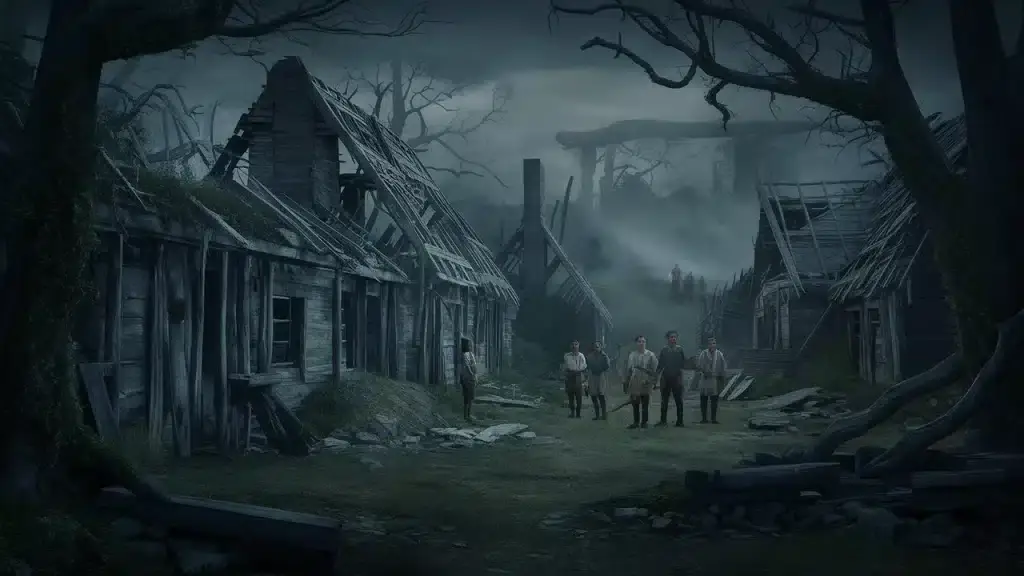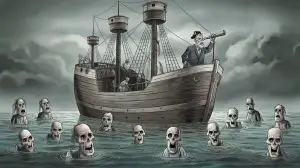The mystery of the Lost Roanoke Colony has puzzled historians for centuries. In 1585, Sir Walter Raleigh attempted to establish the first permanent English settlement in America. However, when a ship arrived in 1590, the settlers had vanished without a trace. The fate of the 112 to 121 colonists remains unknown, becoming one of the most notorious mysteries in American history.

Various theories have emerged about what happened to these settlers. Some believe they were assimilated into local Native American tribes, while others think they may have tried to relocate and perished. New archaeological findings continue to provide insights, but no definitive answers have been found.
The story of Roanoke captivates the imagination due to its many unanswered questions. The settlement’s disappearance has sparked countless investigations, revealing clues but no concrete solutions. This ongoing mystery keeps historians, archaeologists, and curious minds alike searching for the lost colony’s fate.
Historical Context
The Lost Colony of Roanoke is a fascinating tale that unfolds during a time when England was fervently establishing its presence in the New World. This section covers the motivations behind England’s expeditions, the key individuals who played vital roles, and the early attempts to settle Roanoke Island.
England’s Motivations for Colonization
During the late 16th century, England, under the rule of Queen Elizabeth I, aimed to expand its influence and compete with other European powers such as Spain. Colonizing the New World promised new resources, trade routes, and territorial claims.
The English sought to establish a base from which they could launch privateers against Spanish ships laden with treasures from the Americas. Sir Walter Raleigh received a royal charter to explore and settle lands in North America, leading to the birth of the Roanoke expedition. These ambitions were further bolstered by the lure of gold, resources, and the spread of Protestant Christianity.
Key Figures in the Roanoke Voyages
Several key figures shaped the Roanoke expeditions. Sir Walter Raleigh was the driving force behind the colonization efforts. Granted the charter by Queen Elizabeth I, he funded and organized voyages to the New World. Although he never visited Roanoke himself, his vision and investments were instrumental.
John White, the colony’s governor and an artist, played a crucial role in the English settlement. He led the expedition that left behind the mysterious “Croatoan” inscription. His granddaughter, Virginia Dare, was the first English child born in America, symbolizing the hope of a new beginning in Virginia.
First Attempts at Settlement
The first attempt to settle Roanoke Island was fraught with challenges. In 1585, Raleigh sent an initial expedition to establish a colony. Roanoke Island in present-day North Carolina was chosen for its strategic advantages. However, tension with local tribes and supply shortages forced the colonists to abandon the settlement.
A second attempt in 1587, led by John White, sought to create a more permanent colony. Consisting of men, women, and children, this group aimed to establish a lasting presence. White returned to England for supplies, but his return was delayed by the Spanish Armada. When he finally returned in 1590, the colony had vanished, leaving the enduring mystery of the “Lost Colony”.
The Mystery of the Lost Colony
The Lost Colony of Roanoke remains one of the biggest enigmas in American history. This section explores the disappearance of the settlers, the clues they left behind, and the ongoing archaeological investigations.
Disappearance of the Roanoke Settlers
In 1587, John White led a group of 115 English settlers to establish a colony on Roanoke Island. After returning to England for supplies, White was delayed due to war. When he came back in 1590, the colony was deserted.
Croatoan, the only clue left carved into a post, suggested they may have relocated to Croatoan Island. White searched, but bad weather and limited resources prevented a thorough investigation. The fate of the colonists remains unknown, sparking numerous theories.
Clues and Theories
Various clues have fueled speculation. The carving “Croatoan” hinted at relocation. Some believe the settlers integrated with local Native American tribes. The Dare Stones, found mainly in the 1930s, supposedly contain messages from the lost colonists, but their authenticity is debated.
Historians and archaeologists have proposed several theories, including death by disease, starvation, or conflict. Evidence is inconclusive, and each theory has its supporters. Recent discoveries continue to ignite interest and debate over these possibilities.
Archaeological Investigations
Archaeological efforts have focused on sites like “Site X” and areas near Croatoan Island. The Croatoan Archaeological Society and researchers like Mark Horton have unearthed artifacts that might be linked to the lost settlers.
Findings include:
- European pottery
- Tools
- Personal items
These discoveries offer tantalizing hints, but no definitive answers. The search continues, driven by the hope of finally solving the mystery of Roanoke and understanding what happened to its people.
Life in Roanoke
In Roanoke, the settlers experienced a mix of daily routines, interactions with Native American tribes, and significant challenges that shaped their existence on the island.
The Settlers’ Daily Existence
The settlers of Roanoke maintained a structured daily life focused on survival and community building.
Men were typically engaged in activities like hunting, fishing, and constructing shelters. They also gathered wood for fires and tools needed for various tasks.
Women handled domestic duties such as cooking, sewing, and taking care of children. They worked together to plant and harvest crops, relying on both English seeds and local plants available on the island.
In addition to their chores, they socialized through communal meals and shared stories of their homelands. Church gatherings were regular, offering spiritual comfort and a sense of normalcy. Their lifestyle, while challenging, aimed at creating a sustainable settlement.
Relations with Native Americans
The settlers’ contact with Native American tribes, like the Hatteras Indians and Secotan, was crucial for their survival.
At first, they formed friendly relations and traded goods. The Native Americans shared knowledge of local agriculture and survival skills which were invaluable.
Figures like Manteo and Wanchese played significant roles in these interactions, serving as intermediaries.
However, tensions also existed. Misunderstandings often led to conflicts. The settlers’ demands for food and supplies sometimes strained these relationships. Therefore, maintaining stable and peaceful relations was a constant challenge but also a key to addressing their immediate needs.
Challenges and Struggles
Life in Roanoke was far from easy.
A major problem was the lack of supplies. Relied upon for tools, food, and medicine, these essential items often ran out.
Transportation delays from England meant they sometimes waited months for restocking, leading to crises. Harsh weather and unfamiliar diseases also posed constant threats to their survival.
Additionally, the isolation of Roanoke Island compounded these struggles. The settlers had to endure loneliness and separation from loved ones, including wives and families left behind in England. This isolation and tension with the Native American tribes contributed to the mystery that eventually surrounded their disappearance.
Geographic and Cultural Insights
Understanding the geographic and cultural context of the Roanoke Colony helps shed light on its mysterious disappearance. The location on Roanoke Island, its proximity to Hatteras Island, and the area’s unique geography influenced both the settlers and their fate.
Roanoke Island and Surrounding Areas
Roanoke Island is located off the coast of present-day North Carolina. It lies between the mainland and the barrier islands of the Outer Banks.
This location offered both strategic advantages and challenges. The island’s dense forests and marshes made it difficult for settlers to cultivate the land.
The proximity to Pamlico Sound and Albemarle Sound provided access to waterways for travel and trade. However, these same waterways could be treacherous, with unpredictable weather and strong currents.
Settlers relied heavily on supplies from England, but these were unpredictable due to the dangers of the Atlantic Ocean.
The isolation of Roanoke Island, surrounded by water and forests, made it challenging for colonists to communicate with nearby indigenous tribes and establish sustainable food sources.
Hatteras Island and its People
Hatteras Island, another barrier island in the Outer Banks, was inhabited by the Croatoan people. The Croatoans were a vital part of the area’s cultural landscape. They had their own social structure, language, and customs.
When the Roanoke settlers arrived, they faced the challenge of interacting with these native inhabitants.
Initially, relationships with the Croatoan people were crucial for trade and survival.
The Croatoans provided food, knowledge of the land, and assistance to the settlers. This relationship, however, could be strained due to cultural misunderstandings and resources competition.
Historical accounts and recent archaeological findings suggest that some Roanoke colonists may have integrated with the Croatoans over time, seeking refuge from their struggles on Roanoke Island.
Impact of Geography on the Colony’s Fate
The geography of the Outer Banks and the surrounding areas had a profound impact on the fate of the Roanoke Colony. The narrow, shifting barrier islands and the complex network of sounds and inlets made navigation difficult.
These geographic features isolated the colonists, making it hard to receive aid from other settlements or from England. The harsh coastline and lack of fertile land limited agricultural opportunities.
Furthermore, harsh weather conditions like hurricanes and storms frequently battered the area. This made survival even more difficult for the settlers.
The geography itself posed a constant threat, significantly contributing to the colony’s struggles and eventual disappearance. The inaccessibility of safe harbors and the ever-present dangers of the Atlantic Ocean sealed the colony’s fate, leaving it one of America’s enduring historical mysteries.
Legacies and Lasting Questions
The Lost Colony of Roanoke has had far-reaching effects on both history and culture. From influencing future colonization efforts to sparking interest in popular media, its impact continues to be felt today.
Influence on Future Colonization
The mystery of Roanoke deeply influenced later efforts at establishing an English colony in the New World.
Early settlers learned valuable lessons about the challenges they faced, such as supply shortages and the need for better relations with Native Americans. These insights led to more strategic planning and prepared the ground for future, more successful colonies, such as Jamestown, which became the first permanent English settlement.
The Roanoke Legacy in Pop Culture
The Roanoke Colony has left an enduring mark on popular culture. Stories of the first English child born in the Americas, Virginia Dare, have been romanticized in books, movies, and TV shows.
Whether in historical novels or supernatural series, the fate of the Lost Colony remains a source of intrigue and creativity. Its mythos endures through various media, reflecting the blending of historical fact and fiction that keeps audiences captivated.
Unsolved Mysteries and Continued Interest
Despite numerous efforts by archaeologists and historians, the fate of the Lost Colony remains an unsolved mystery.
Archaeological evidence, such as findings at “Site X,” suggests possible relocation efforts, but definitive answers are elusive. The word “Croatoan,” carved into a tree, hints at interactions with local tribes, yet concrete conclusions are still lacking.
The ongoing search for answers keeps the story alive, fueling interest and speculation throughout the years.
Notable Artifacts and Sites

Several artifacts and significant locations have been linked to the Lost Roanoke Colony. Each discovery offers valuable clues about the fate of the settlers and the life they led.
Artifact Discoveries and Analysis
Archaeologists have unearthed numerous artifacts related to the Roanoke Colony. At Site X in Bertie County, items such as pottery, iron nails, and an aglet were found, suggesting some colonists moved inland.
In Hatteras, a gold signet ring believed to be linked to a Roanoke colonist was discovered, offering a tangible connection to the past.
Another significant find includes Cape Creek artifacts, which comprise European pottery mixed with Native American items from the mid-17th century. These artifacts hint at interaction between the settlers and local tribes. Additionally, pieces of Border Ware pottery and an iron rapier were identified, symbolizing the European presence.
Significant Locations Related to the Colony
Roanoke Island remains the most famous site associated with the colony, primarily due to the word “Croatoan” carved into a post.
However, Hatteras Island is another essential location, with archaeological evidence suggesting that some settlers may have integrated with local tribes there.
Albemarle Sound, located about 50 miles west of Roanoke Island, has also yielded crucial findings such as pottery and metal artifacts. These discoveries imply that the colonists might have dispersed to different regions, seeking refuge or forming new communities inland.
Furthermore, the palisade, a defensive structure on Roanoke Island, indicates the settlers’ attempts to protect themselves from potential threats.
Theories and Explanations

Several theories attempt to explain the fate of the Lost Colony of Roanoke. Some believe the colonists integrated with Native American tribes, while others think they relocated and assimilated elsewhere. Conspiracy theories also make wild speculations about their disappearance.
Integrating with Native American Tribes
One popular theory is that the Lost Colony integrated with Native American tribes. The nearby Hatteras Indians, also known as the Croatoan, are frequently mentioned.
Some evidence supporting this theory includes European artifacts found in Native American settlements and records of fair-haired, blue-eyed individuals in these tribes. Explorers like John White also noted the word “Croatoan” carved into a post, hinting at the colonists’ potential move to a friendly tribe.
Possible Relocation and Assimilation
Another theory suggests the colonists may have attempted to relocate and assimilate into other English settlements.
Jamestown, established in Virginia years later, might have absorbed some Roanoke survivors. Historical records indicate that communication between Jamestown and regions like Newfoundland existed.
This theory is bolstered by reports of Native Americans in these areas speaking English and wearing English-style clothes, hinting at the colonists’ influence.
Conspiracy Theories and Speculation
Various conspiracy theories and speculative ideas have arisen over the centuries. Some suggest the settlers were abducted, possibly by other European powers or even supernatural forces.
Others believe there was a secret plan involving the Spanish or even internal conflicts within the colony. These ideas are less substantiated by historical evidence but capture the imagination due to their mysterious nature.
The phrase “Croatoan” has sparked numerous wild stories, including its rumored connections to other unexplained disappearances in history.
Recent Developments and Discoveries

Recent research into the Lost Colony of Roanoke has yielded exciting findings. New archaeological evidence and technological advancements have brought fresh insights into this centuries-old mystery.
Modern Archaeological Efforts
Archaeologists, such as those from the First Colony Foundation, have made significant strides in uncovering clues about the Lost Colony of Roanoke.
Nicholas Luccketti and his team have uncovered artifacts that suggest interactions between the English settlers and local Indigenous groups. These findings may provide crucial context about the settlers’ fate.
One key focus has been the area called the Croatoan Project. This project aims to identify sites where the colonists might have moved after abandoning Roanoke Island.
Discoveries in this area have included English pottery and tools, indicating a possible integration with local tribes.
Technological Advances in Research
Recent technological advances have revolutionized how researchers study the colonists’ disappearance. Techniques like ground-penetrating radar and DNA analysis have allowed archaeologists to uncover artifacts and human remains without extensive digging.
These technologies have made it possible to identify European artifacts buried deep underground. Additionally, computer simulations have helped researchers reconstruct environmental conditions, such as droughts, that the colonists might have faced. These methods contribute to a more comprehensive understanding of the challenges the settlers encountered. They also include interactions with local tribes and possible sightings of Spanish ships.
Steve is the creative force behind Unique Tales, a blog dedicated to sharing captivating stories that explore the human experience in all its complexity. With a passion for writing and a talent for crafting engaging narratives, Steve's blog is a treasure trove of imaginative tales that transport readers to other worlds and challenge them to see things from new perspectives. From epic adventures to intimate character studies, Steve's stories are always thought-provoking and emotionally resonant. With a growing following of readers who appreciate his unique voice and creative vision, Steve is quickly becoming a rising star in the world of online storytelling.






